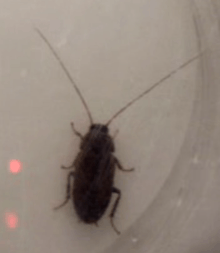Diploptera punctata
| Pacific beetle cockroach | |
|---|---|
 | |
| Laboratory colony specimen adult Diploptera punctata (Pacific beetle cockroach) | |
| Scientific classification | |
| Kingdom: | Animalia |
| Phylum: | Arthropoda |
| Class: | Insecta |
| Order: | Blattodea |
| Family: | Blaberidae |
| Subfamily: | Blaberinae |
| Genus: | Diploptera |
| Species: | D. punctata |
| Binomial name | |
| Diploptera punctata | |
Diploptera punctata or Pacific beetle cockroach is a species of cockroach in the family Blaberidae, subfamily Diplopterinae. It is one of the few cockroach species which are viviparous. They also produce a nutritionally dense crystalline "milk"[1] for their young.[2][3][4] Adults are chemically defended, having a modified tracheal gland and spiracle on each side which squirts quinones which can poison or discourage a predator.[5]
Geographic distribution
It can be found living in Australia, Myanmar, China, Fiji, Hawaii, India
Other names
Diploptera punctata has previously been known by these other names:
- Blatta punctata Eschscholtz, 1822.
- Blatta dytiscoides Serville, 1838.
- Diploptera silpha Saussure, 1864.
References
George Beccaloni; David C. Eades. "Diploptera punctata". Blattodea Species File. Retrieved 10 June 2011.
- ↑ Williford, Anna; Stay, Barbara; Bhattacharya, Debashish (2004-03-01). "Evolution of a novel function: nutritive milk in the viviparous cockroach, Diploptera punctata". Evolution & Development. 6 (2): 67–77. doi:10.1111/j.1525-142X.2004.04012.x. ISSN 1525-142X.
- ↑ Banerjee, Sanchari; Coussens, Nathan; Gallat, François-Xavier; et al. (2016-07). "Structure of a heterogeneous, glycosylated, lipid-bound, in vivo-grown protein crystal at atomic resolution from the viviparous cockroach Diploptera punctata". IUCrJ. 3 (4): 282–293. doi:10.1107/S2052252516008903. Retrieved 31 July 2016. Check date values in:
|date=(help) - ↑ Kumar, Chethan (2016-07-19). "Pesky cockroaches give scientists some high-protein food for thought". Times of India. Retrieved 31 July 2016.
- ↑ Guarino, Ben (2016-07-26). "The case for cockroach milk: The next superfood?". Washington Post. Retrieved 31 July 2016.
- ↑ Roth, Louis M.; Stay, Barbara (1958-01-01). "The occurrence of para-quinones in some arthropods, with emphasis on the quinone-secreting tracheal glands of Diploptera punctata (Blattaria)". Journal of Insect Physiology. 1 (4): 305–318. doi:10.1016/0022-1910(58)90049-0.
This article is issued from Wikipedia - version of the 11/17/2016. The text is available under the Creative Commons Attribution/Share Alike but additional terms may apply for the media files.